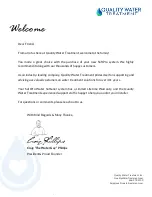
24
4. Put cap with male adapter back on the container and slide 3/4”
hose over end of male adapter and fasten in place using hose
clamp provided.
DELIME USING FLO-JUG METHOD
5. Slide the hose clamp over end of hose and slide hose over the
male adapter in the water heater drain opening and secure in
place using hose clamp.
6. Lift container to the “Pour” Position being careful to keep the vent
in the handle above the liquid level and pour the UN•LIME into
the heater.
7. Lower container, you may have to place the container on its empty
carton to prevent the UN•LIME from flowing back into the container.
8. Let UN•LIME remain in the heater for 5 minutes and then lower
the container to the “Drain” Position.
9. Deliming activity is indicated by foaming on the surface of the
UN•LIME. If there is deliming activity, repeat steps 6 thru 8.
Normally, lime removal will be completed within one hour. Severe
build-up of lime may take longer than an hour to complete descaling.
Note: To check UN•LIME for continued use, place some scale or white
chalk in a glass with a small amount of UN•LIME. If the material is
vigorously dissolved by the UN•LIME, it can be reused; if not, the
UN•LIME should be replaced.
If the temperature-pressure relief valve on the appliance weeps or
discharges periodically, this may be due to thermal expansion. You
may have a check valve installed in the water line or a water meter
with a check valve. Consult your local water supplier or service
technician for further information. Do not plug the temperature-
pressure relief valve.
DRAINING AND FLUSHING
It is recommended that the water heater storage tank be
drained and flushed every 6 months to reduce sediment
buildup. The water heater should be drained if being shut down
during freezing temperatures. See Installation Considerations
in this manual for the location of the water heater components
described below.
Burn harzard.
Hot water discharge.
Keep hands clear of drain
valve discharge.
TO DRAIN THE WATER HEATER STORAGE TANK:
1.
Turn off the gas supply at the Main Gas Shutoff Valve if the
water heater is going to be shut down for an extended period.
2.
Ensure the cold water inlet valve is open.
3.
Open a nearby hot water faucet and let the water run until
the water is no longer hot.
4.
Close the cold water inlet valve to the water heater.
5.
Connect a hose to the water heater drain valve and
terminate it to an adequate drain.
6. Open the water heater drain valve and allow all the water to
drain from the storage tank.
7. Close the water heater drain valve when all water in the
storage tank has drained.
8.
Close the hot water faucet opened in Step 4.
9.
If the water heater is going to be shut down for an extended
period, the drain valve should be left open.
TO FLUSH THE WATER HEATER STORAGE TANK:
1.
Ensure the cold water inlet valve is open.
2.
Open a nearby hot water faucet and let the water run until
the water is no longer hot. Then close the hot water faucet.
3.
Connect a hose to the drain valve and terminate it to an
adequate drain.
4.
Ensure the drain hose is secured before and during the
entire flushing procedure. Flushing is performed with
system water pressure applied to the water heater.
5.
Open the water heater drain valve to flush the storage tank.
6.
Flush the water heater storage tank to remove sediment
and allow the water to flow until it runs clean.
7.
Close the water heater drain valve when flushing is
completed.
8.
Remove the drain hose.
9.
Fill the water heater - see Filling The Water Heater in this manual.
10.
Turn on the gas supply to the water heater at the Main Gas
Shutoff Valve.
11.
Allow the water heater to complete several heating cycles
to ensure it is operating properly.
SERVICE
Before calling for repair service, read the “Start Up Conditions” and
“Operational Conditions” found in the “For Your Information” section
of this manual.
If a condition persists or you are uncertain about the operation of the
water heater contact a service technician. If you are not thoroughly
familiar with gas codes, your water heater, and safety practices, contact
your gas supplier or qualified installer to check the water heater.
Use the ”Leakage Checkpoints” guide to check a “Leaking”
water heater. Many suspected “Leakers” are not leaking tanks. Often
the source of the water can be found and corrected.
Read this manual first. Then before checking the water heater make
sure the gas supply has been turned “OFF”, and never turn the gas
“ON” before the tank is completely full of water.
Never use this water heater unless it is completely filled with water.
To prevent damage to the tank, the tank must be filled with water.
Water must flow from the hot water faucet before turning “ON” gas
to the water heater.
Содержание BL-80
Страница 4: ...4 GENERAL SAFETY INFORMATION...
Страница 33: ...33 NOTES...
Страница 34: ...34 NOTES...













































